Dean Smith
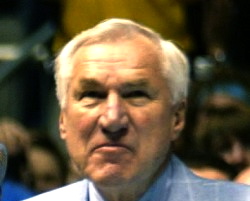
Dean Smith – SportsCentury
All rights belong to ESPN and Sportscentury.
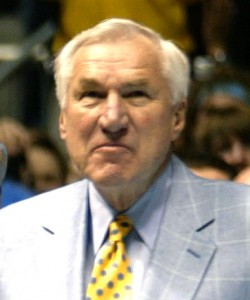 Smith at a North Carolina game on February 10, 2007
Smith at a North Carolina game on February 10, 2007
Dean Edwards Smith (born February 28, 1931 – died February 7, 2015) was an American head coach of men’s college basketball. Originally from Emporia, Kansas, Smith was called a “coaching legend” by the Basketball Hall of Fame. Smith was best known for his 36-year coaching tenure at the University of North Carolina at Chapel Hill. Smith coached from 1961 to 1997 and retired with 879 victories, which was the NCAA Division I men’s basketball record at that time. Smith had the 9th highest winning percentage of any men’s college basketball coach (77.6%). During his tenure as head coach, North Carolina won two national championships and appeared in 11 Final Fours.
Smith was also known for running a clean program and having a high graduation rate, with 96.6% of his athletes receiving their degrees. While at North Carolina, Smith helped promote desegregation by recruiting the university’s first African American scholarship basketball player, Charlie Scott, and pushing for equal treatment for African Americans by local businesses. Smith coached and worked with numerous people at North Carolina who went on to achieve notable success in basketball, as either players or coaches or both. Smith retired in 1997, saying that he was not able to give the team the same level of enthusiasm that he had given it for years. After retiring, Smith used his influence to help various charitable ventures and liberal political activities, but in his latter years he suffered from advanced dementia and ceased most public activities.
Biography – Early Years
Smith was born in Emporia, Kansas, on February 28, 1931. Both of his parents were public school teachers. Smith’s father, Alfred, coached the Emporia High Spartans basketball team to the 1934 state title in Kansas. This 1934 team was notable for having the first African-American basketball player in Kansas tournament history. While at Topeka High School, Smith lettered in basketball all four years and was named all-state in basketball as a senior. Smith’s interest in sports was not limited only to basketball. Smith also played quarterback for his high school football team and catcher for the high school baseball team.
College Years
After graduating from high school, Smith attended the University of Kansas on an academic scholarship where he majored in mathematics and joined Phi Gamma Delta fraternity. While at Kansas, Smith continued his interest in sports by playing varsity basketball, varsity baseball, and freshman football, and was a member of the Air Force ROTC detachment. During his time on the varsity basketball team, Kansas won the national championship in 1952 and were NCAA tournament finalists in 1953. Smith’s basketball coach during his time at Kansas was Phog Allen, who had been coached at the University of Kansas by the inventor of basketball, James Naismith. After graduation, Smith served as assistant coach at Kansas in the 1953–54 season.
Coaching Career – Early Years in Basketball Coaching
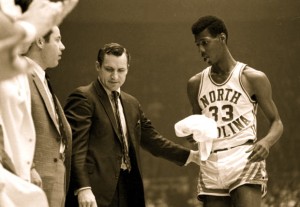 Smith next served a stint in the United States Air Force in Germany, later working as a head coach of United States Air Force Academy’s baseball and golf teams. Yet, Smith’s big break would come in the United States. In 1958, North Carolina coach Frank McGuire asked Smith to join his staff as an assistant coach. Smith served under McGuire for three years until 1961, when McGuire was forced to resign by Chancellor William Aycock in the wake of a major recruiting scandal, and consequently, an NCAA mandated probation. Aycock told WNCN that McGuire told him he was leaving on a Saturday, and Aycock called in Smith and hired him that day.
Smith next served a stint in the United States Air Force in Germany, later working as a head coach of United States Air Force Academy’s baseball and golf teams. Yet, Smith’s big break would come in the United States. In 1958, North Carolina coach Frank McGuire asked Smith to join his staff as an assistant coach. Smith served under McGuire for three years until 1961, when McGuire was forced to resign by Chancellor William Aycock in the wake of a major recruiting scandal, and consequently, an NCAA mandated probation. Aycock told WNCN that McGuire told him he was leaving on a Saturday, and Aycock called in Smith and hired him that day.
In addition, all of this occurred amid rumors of a point-shaving scandal involving UNC players. Smith was told at first that wins and losses didn’t matter nearly so much as simply running a clean program and representing the university well.
The Atlantic Coast Conference (ACC) had canceled the Dixie Classic, an annual basketball tournament in Raleigh, North Carolina, due to a national point shaving scandal including a North Carolina player (Lou Brown). As a result of the scandal, North Carolina de-emphasized basketball by cutting their regular-season schedule. In Smith’s first season from 1961–62, North Carolina played only 17 games and went 8-9. As it turned out, this would be the only losing season he would ever suffer. In 1965, he was famously hanged in effigy on the university campus following a disappointing loss to Wake Forest. After that game, his team ended up winning nine of the last eleven games. After a slow beginning, Smith turned the program into a consistent success. After the 1966 season, Smith’s teams never finished worse than a tie for third in the ACC; for the first 20 of those years, they didn’t finish worse than a tie for second. By comparison, during that time the ACC’s other charter members each finished last at least once.
His first major successes came in the late 1960’s, when his teams won consecutive regular-season and ACC tournament championships, and went to three straight Final Fours. Fortunately, this run occurred in the middle of UCLA’s run of 10 titles in 12 years; in fact Smith lost to UCLA’s John Wooden in the 1968 title game!
It took Smith seven trips to the Final Four before winning his first national title, and then it took him nine more years to return, and two more to get another national championship.
First National Championship
 Michael Jordan and Dean Smith at the University of North Carolina at Chapel Hill 2007 game honoring the 1957 and 1982 men’s basketball teams.
Michael Jordan and Dean Smith at the University of North Carolina at Chapel Hill 2007 game honoring the 1957 and 1982 men’s basketball teams.
Dean Smith’s first national championship occurred in 1982, when the team was composed of future NBA players such as Michael Jordan, James Worthy and Sam Perkins. After winning the NCAA Tournament, North Carolina had a record of 32-2. The other teams that advanced with North Carolina were Georgetown, Houston and Louisville. In the Semifinals, North Carolina defeated Houston 68-63 in New Orleans, while Georgetown defeated Louisville 50-46.
The national title game against Georgetown was evenly matched throughout. However, with 17 seconds left on the clock, and the Tar Heels behind by 1 point, Jordan made what ended up being the game-winning shot to put the Tar Heels up 63-62. On Georgetown’s ensuing possession, Hoya guard Fred Brown mistakenly passed the ball to Worthy. Worthy attempted to dribble out the clock, but was fouled with 2 seconds left. He missed both free throws, but Georgetown had no timeouts left. The Hoyas missed a halfcourt shot and lost the game.
Second National Championship
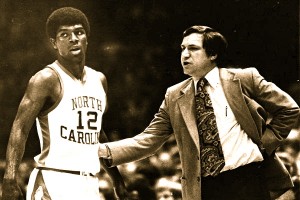 Dean Smith’s 1993 squad featured George Lynch, Eric Montross, Brian Reese, Donald Williams, and Derrick Phelps. The Tar Heels started out with an 8-0 record and were ranked #5 in the country when they met #6 Michigan in the semi-finals of the Rainbow Classic. The Wolverines, led by the Fab Five in their sophomore season, won 79-78 on a last-second shot. North Carolina bounced back with nine straight wins before losing back-to-back road games against unranked Wake Forest and #5 Duke. After seven more straight wins, the Tar Heels were ranked #1 heading into the last week of the regular season (their first #1 ranking since the start of the 1987-88 season). North Carolina beat #14 Wake Forest and #6 Duke to close out the regular season and clinch the top seed in the ACC tournament. North Carolina reached the tournament final, but they lost 77-75 to Georgia Tech without Derrick Phelps, who was injured. Nonetheless, North Carolina was awarded the top seed in the East Regional of the NCAA Tournament, defeating #16-seed East Carolina (85-65), #8-seed Rhode Island (112-67), #4-seed Arkansas (80-74) and #2-seed Cincinnati (75-68) to reach the Final Four in New Orleans.
Dean Smith’s 1993 squad featured George Lynch, Eric Montross, Brian Reese, Donald Williams, and Derrick Phelps. The Tar Heels started out with an 8-0 record and were ranked #5 in the country when they met #6 Michigan in the semi-finals of the Rainbow Classic. The Wolverines, led by the Fab Five in their sophomore season, won 79-78 on a last-second shot. North Carolina bounced back with nine straight wins before losing back-to-back road games against unranked Wake Forest and #5 Duke. After seven more straight wins, the Tar Heels were ranked #1 heading into the last week of the regular season (their first #1 ranking since the start of the 1987-88 season). North Carolina beat #14 Wake Forest and #6 Duke to close out the regular season and clinch the top seed in the ACC tournament. North Carolina reached the tournament final, but they lost 77-75 to Georgia Tech without Derrick Phelps, who was injured. Nonetheless, North Carolina was awarded the top seed in the East Regional of the NCAA Tournament, defeating #16-seed East Carolina (85-65), #8-seed Rhode Island (112-67), #4-seed Arkansas (80-74) and #2-seed Cincinnati (75-68) to reach the Final Four in New Orleans.
In the National Semifinals, Smith’s Tar Heels defeated his alma mater Kansas (coached by future North Carolina coach Roy Williams) 78-68, setting up a rematch with #3-ranked Michigan in the Finals.
The national title game was a see-saw battle throughout, but is remembered best for Chris Webber calling a time-out that Michigan didn’t have with seconds left. Michigan was assessed a technical foul and North Carolina ended up winning 77-71, giving Smith his second national championship.
Retirement
Smith announced his retirement on October 9, 1997. He had said that if he ever felt he could not give his team the same enthusiasm he had given it for years, he would retire. His announcement was unexpected, as he had given little warning that he was considering retirement. Bill Guthridge, his assistant for 30 years, succeeded him as head coach.
During his retirement, Smith had a large influence on the North Carolina basketball program. In 2003 Smith talked to Roy Williams regarding his decision about whether or not to replace a struggling Matt Doherty as head coach. Williams had previously declined the head coaching position three years earlier when Guthridge retired.
In July 2010, John Feinstein disclosed that he had abandoned a biography of Smith because of Smith’s deteriorating memory. Shortly after, Smith’s family released a letter on July 17, 2010, stating that he had a “progressive neurocognitive disorder,” which has not been publicly disclosed as Alzheimer’s or anything else. He had trouble remembering the names of some of his players, the letter said, but he could not forget what his relationships with those players meant. He also remembered words to hymns and jazz standards, but did not go to concerts. He had difficulty with traveling but continued to watch his former team on TV. Williams said, “He does have his good days and bad.”
Coaching Style
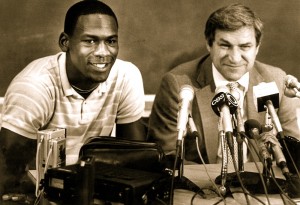 Smith-coached teams varied in style, depending on the players Smith had available. But they generally featured a fast-break style, a half-court offense that emphasized the passing game, and an aggressive trapping defense that produced turnovers and easy baskets. From 1970 until his retirement, his teams featured an impressive shooting percentage of over 50% in all but four years.
Smith-coached teams varied in style, depending on the players Smith had available. But they generally featured a fast-break style, a half-court offense that emphasized the passing game, and an aggressive trapping defense that produced turnovers and easy baskets. From 1970 until his retirement, his teams featured an impressive shooting percentage of over 50% in all but four years.
Smith was credited with creating or popularizing the following basketball techniques: The “tired signal,” in which a player would use a hand signal (originally a raised fist) to indicate that he needed to come out for a rest, huddling at the free throw line before a foul shot, encouraging players who scored a basket to point a finger at the teammate who passed them the ball, in honor of the passer’s selflessness, instituting a variety of defensive sets in one game, having the point guard call out the defense set for the team, and creating a number of defensive sets, including the point zone, the run-and-jump, and double-teaming the screen-and-roll.
But strategically, Smith was most associated with his implementation of the four corners offense, a strategy for stalling with a lead near the end of the game. Smith’s teams executed the four corners set so effectively that in 1985 the NCAA instituted a shot clock to speed up play and minimize ball-control offense. Although fellow Kansas alum John McLendon actually invented the four corners offense, Smith was better known for utilizing it in games. Smith was also the author of Basketball: Multiple Offense and Defense, which is the best-selling technical basketball book in history.
Smith also instituted the practice of starting all his team’s seniors on the last home game of the season (“Senior Day”) as a way of honoring the contributions of the subs as well as the stars. In a season when the team included six seniors, he put all six on the floor at the beginning of the game – drawing a technical foul – rather than leave one of them out.
During the 1993 run for the national title, Smith used a method that was introduced to him at a conference in Switzerland. At the conference, Smith was presented a tape by a lecturer who used doctored images to achieve his goal of losing weight. The photos showed the lecturer what he would look like if he were thinner as motivation to reach his weight-loss goals. Smith took a picture of the scoreboard from the 1982 Championship, modified it to read 1993 and erased the name Georgetown, leaving that space blank. He proceeded to place copies of the doctored photo in all of the players’ lockers.
Personal Life
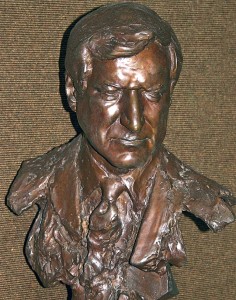 Bust of Dean Smith at the Dean Smith Center. Photo credit: Rob Goldberg
Bust of Dean Smith at the Dean Smith Center. Photo credit: Rob Goldberg
Smith married Ann Cleavinger in 1954, shortly before his deployment overseas with the United States Air Force. They had three children: daughters Sharon and Sandy, and son Scott. Smith and Cleavinger divorced in 1973. Smith married Linnea Weblemoe on May 21, 1976. They have two adult daughters, Kristen and Kelly.
Death
According to a statement released by Smith’s family, Smith “died the evening of February 7, 2015, at his home in Chapel Hill, and surrounded by his wife and five children,” at the age of 83.

